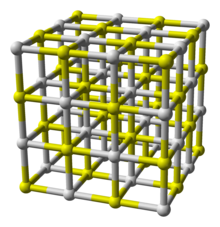|
Calcium sulfide
Calcium sulfide is the chemical compound with the formula CaS. This white material crystallizes in cubes like rock salt. CaS has been studied as a component in a process that would recycle gypsum, a product of flue-gas desulfurization. Like many salts containing sulfide ions, CaS typically has an odour of H2S, which results from small amount of this gas formed by hydrolysis of the salt. In terms of its atomic structure, CaS crystallizes in the same motif as sodium chloride indicating that the bonding in this material is highly ionic. The high melting point is also consistent with its description as an ionic solid. In the crystal, each S2− ion is surrounded by an octahedron of six Ca2+ ions, and complementarily, each Ca2+ ion surrounded by six S2− ions. ProductionCaS is produced by carbothermic reduction of calcium sulfate, which entails the conversion of carbon, usually as charcoal, to carbon dioxide:
and can react further: In the second reaction the sulfate (+6 oxidation state) oxidizes the sulfide (-2 oxidation state) to sulfur dioxide (+4 oxidation state), while it is being reduced to sulfur dioxide itself (+4 oxidation state). CaS is also a byproduct in the Leblanc process, a once major industrial process for producing sodium carbonate. In that process sodium sulfide reacts with calcium carbonate:[1]
Millions of tons of this calcium sulfide byproduct was discarded, causing extensive pollution and controversy.[2] Milk of lime, Ca(OH)2, reacts with elemental sulfur to give a "lime-sulfur", which has been used as an insecticide. The active ingredient is probably a calcium polysulfide, not CaS.[3] Reactivity and usesCalcium sulfide decomposes upon contact with water, including moist air, giving a mixture of Ca(SH)2, Ca(OH)2, and Ca(SH)(OH).
It reacts with acids such as hydrochloric acid to release toxic hydrogen sulfide gas.
Calcium sulfide is phosphorescent, and will glow a blood red for up to an hour after a light source is removed.[4] As a noxious byproduct of the Leblanc process, it can be converted to calcium carbonate and hydrogen sulfide, the latter of which can be used as a sulfur source for the lead chamber process to produce the sulfuric acid necessary for the Leblanc process:
Natural occurrenceOldhamite is the name for mineralogical form of CaS. It is a rare component of some meteorites and has scientific importance in solar nebula research.[5][6] Burning of coal dumps can also produce the compound.[7] See alsoReferences
|
||||||||||||||||||||||||||||||||||||||||||||||||||||||||||||||||||||||||||||||||||||||||




